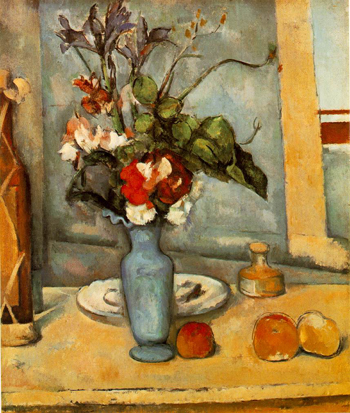| Search Art Prints | ||||||||||||||||||||
| Search Artists | ||||||||||||||||||||

|
||||||||||||||||||||
|
|
|||||||||||||||||||

Le Vase Bleualso known as The Blue Vase, Still Life

|
Flowers and fruit: that was Cézanne's nickname. They were two of his favorite themes, though he admitted to preferring fruit (he supposedly told Gachet that [flowers] fade immediately. Fruit is more reliable.) In Le vase bleu, they are wonderfully combined.
Not exhibited until 1904, two years before Cézanne's death, Le vase bleu is surprisingly simple and sober. It is quite removed from flower pieces from the likes of Renoir, which usually conveyed an exuberant mood and an ostentatious richness of color. The apples are a notable difference from a typical flower piece, but what really sets this piece apart is the subtle color modulation, which Cézanne focuses on so much that the blooms of the flowers seems almost ignored. The way light falls on objects and the resulting changes of color were major preoccupations for Cézanne.
The piece is centered precisely on the vase standing on the table. Space is cleverly constructed via an interplay of horizontals and verticals, and of a balanced distribution of volumes. The use of subtle shades of blue has an anchoring effect: the painting remains unified by the shifting tones of blue found throughout.
In Cézanne's catalogue, Le vase bleu has its closest relatives in the flower pieces Cézanne painted ten years earlier at Auvers-sur-Oise. Le vase and those pieces share the same overall construction and mood, but Le vase's apples (and their notable coloration) and its auspicious lighting effects secure its reputation as more than just a belated continuation of the Auvers series.











